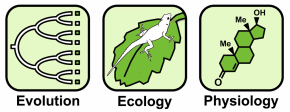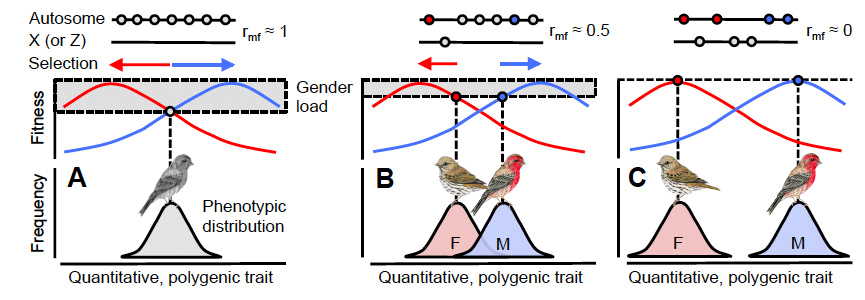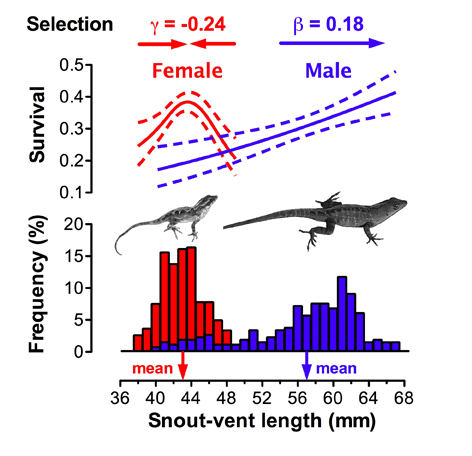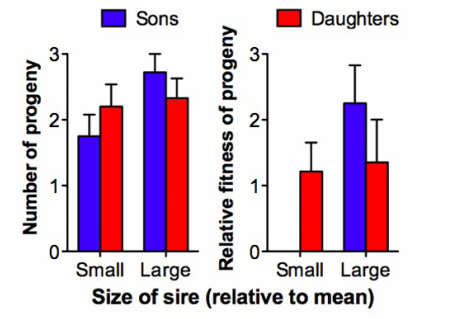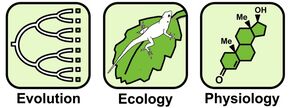Intralocus sexual conflict
All species with separate sexes face a common problem: males and females share most of the same genes for traits that are often subject to dramatic differences in natural and sexual selection. Consequently, genes that are detrimental when expressed in one sex may be maintained in a population because they are favored in the opposite sex, creating a gender load that reduces the fitness of the population. This is referred to as intralocus sexual conflict.
To resolve intralocus sexual conflict, male and female phenotypes must move toward their respective fitness optima, which means that sexual dimorphism must evolve. Mechanistically, this requires some form of sex-biased inheritance (sex linkage, adaptive sex allocation) or expression (sex-specific splicing, sex-biased transcription, genomic imprinting) of shared genes. If conflict is unresolved, then high-fitness parents will produce high-fitness progeny of the same sex, but low-fitness progeny of the opposite sex, resulting in a negative between-sex genetic correlation for fitness.
We study (1) the aspects of natural and sexual selection that give rise to sexual conflict, (2) the phenotypic traits that are under sexually antagonistic selection, (3) the quantitative genetics of fitness and of shared traits, and (4) the roles of sex steroids, sex-biased gene expression, and adaptive sex allocation in resolving sexual conflict. The figures above are modified from Cox & Calsbeek 2010b (left) and Cox & Calsbeek 2010a (right).
Relevant publications
Wittman, T.N., C.D. Robinson, J.W. McGlothlin and R.M. Cox. 2021. Hormonal pleiotropy structures genetic covariance. Evolution Letters.
Reedy, A.M., W.J. Evans and R.M. Cox. 2019. Sexual dimorphism explains residual variance around the survival-reproduction tradeoff in lizards: Implications for sexual conflict over life-history evolution. Evolution 73: 2324-2332.
McGlothlin, J.W., R.M. Cox, and E.D. Brodie III. 2019. Sex-specific selection and the evolution of between-sex genetic covariance. Journal of Heredity 110: 422-432.
Cox, R.M., C.L. Cox, J.W. McGlothlin, D. Card, A. Andrew, and T.A. Castoe. 2017. Hormonally mediated increases in sex-biased gene expression accompany the breakdown of between-sex genetic correlations in a sexually dimorphic lizard. The American Naturalist 189: 315-332.
Cox, R.M., R.A. Costello, B. Camber, and J.W. McGlothlin. 2017. Multivariate genetic architecture of the Anolis dewlap reveals both shared and sex-specific features of a sexually dimorphic ornament. Journal of Evolutionary Biology 30: 1262-1275.
Calsbeek, R., M.C. Duryea, P. Bergeron, D. Goedert, and R.M. Cox. 2015. Intralocus sexual conflict, adaptive sex allocation, and the heritability of fitness. Journal of Evolutionary Biology 28: 1975-1985.
Cox, R.M., M.C. Duryea, M. Najarro and R. Calsbeek. 2011. Paternal condition drives sex-ratio bias in a lizard that lacks parental care. Evolution 65: 220-230.
Cox, R.M., and R. Calsbeek. 2010a. Cryptic sex-ratio bias provides indirect genetic benefits despite sexual conflict. Science 328: 92-94.
Cox, R.M., and R. Calsbeek. 2010b. Sex-specific selection and intraspecific variation in sexual size dimorphism. Evolution 64: 798-809.
Connallon, T., R.M. Cox, and R. Calsbeek. 2010. Fitness consequences of sex-specific selection. Evolution 64: 1671-1682.
Cox, R.M., and R. Calsbeek. 2009. Sexually antagonistic selection, sexual dimorphism and the resolution of intralocus sexual conflict. American Naturalist 173: 176-187.
Wittman, T.N., C.D. Robinson, J.W. McGlothlin and R.M. Cox. 2021. Hormonal pleiotropy structures genetic covariance. Evolution Letters.
Reedy, A.M., W.J. Evans and R.M. Cox. 2019. Sexual dimorphism explains residual variance around the survival-reproduction tradeoff in lizards: Implications for sexual conflict over life-history evolution. Evolution 73: 2324-2332.
McGlothlin, J.W., R.M. Cox, and E.D. Brodie III. 2019. Sex-specific selection and the evolution of between-sex genetic covariance. Journal of Heredity 110: 422-432.
Cox, R.M., C.L. Cox, J.W. McGlothlin, D. Card, A. Andrew, and T.A. Castoe. 2017. Hormonally mediated increases in sex-biased gene expression accompany the breakdown of between-sex genetic correlations in a sexually dimorphic lizard. The American Naturalist 189: 315-332.
Cox, R.M., R.A. Costello, B. Camber, and J.W. McGlothlin. 2017. Multivariate genetic architecture of the Anolis dewlap reveals both shared and sex-specific features of a sexually dimorphic ornament. Journal of Evolutionary Biology 30: 1262-1275.
Calsbeek, R., M.C. Duryea, P. Bergeron, D. Goedert, and R.M. Cox. 2015. Intralocus sexual conflict, adaptive sex allocation, and the heritability of fitness. Journal of Evolutionary Biology 28: 1975-1985.
Cox, R.M., M.C. Duryea, M. Najarro and R. Calsbeek. 2011. Paternal condition drives sex-ratio bias in a lizard that lacks parental care. Evolution 65: 220-230.
Cox, R.M., and R. Calsbeek. 2010a. Cryptic sex-ratio bias provides indirect genetic benefits despite sexual conflict. Science 328: 92-94.
Cox, R.M., and R. Calsbeek. 2010b. Sex-specific selection and intraspecific variation in sexual size dimorphism. Evolution 64: 798-809.
Connallon, T., R.M. Cox, and R. Calsbeek. 2010. Fitness consequences of sex-specific selection. Evolution 64: 1671-1682.
Cox, R.M., and R. Calsbeek. 2009. Sexually antagonistic selection, sexual dimorphism and the resolution of intralocus sexual conflict. American Naturalist 173: 176-187.
